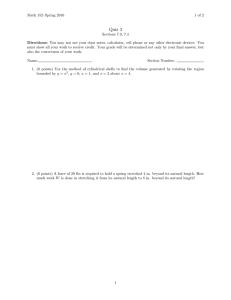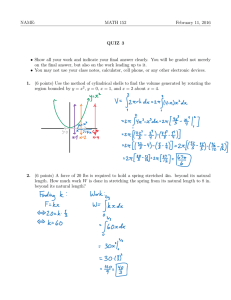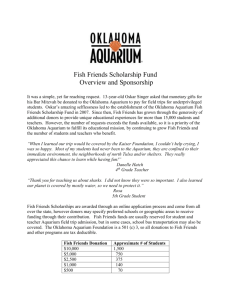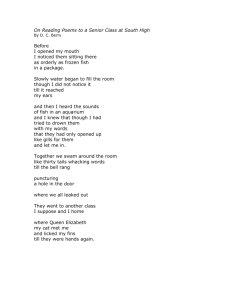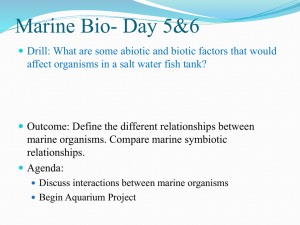Focusing on Function: Thinking Below the Surface of Complex Natural Systems
advertisement
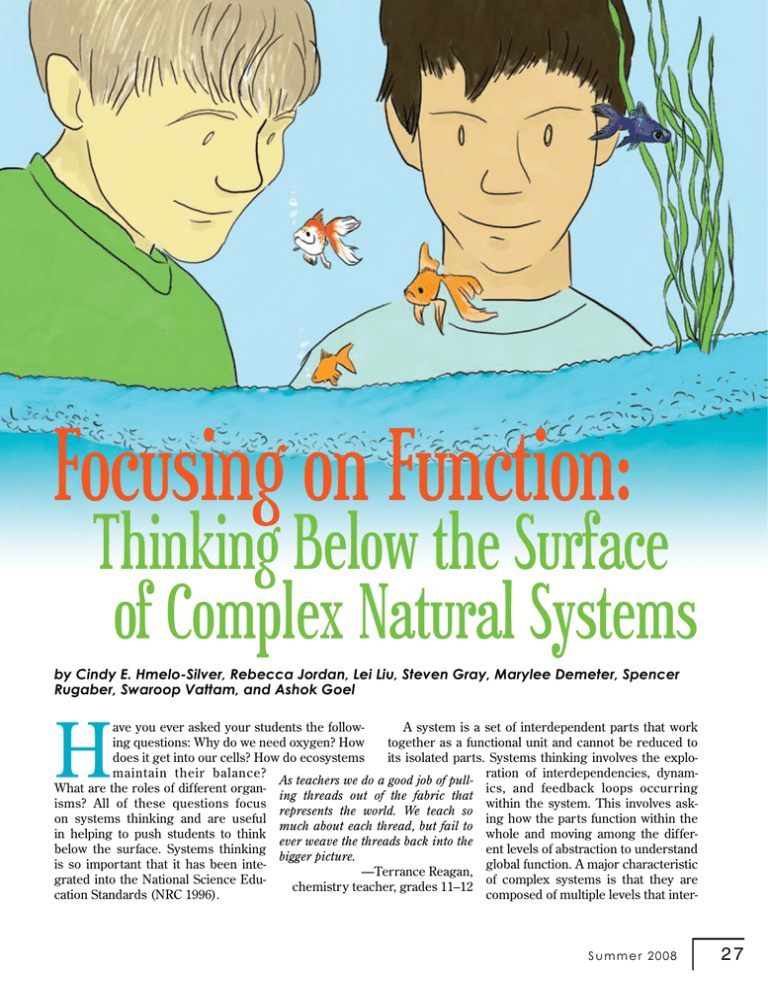
Focusing on Function: Thinking Below the Surface of Complex Natural Systems by Cindy E. Hmelo-Silver, Rebecca Jordan, Lei Liu, Steven Gray, Marylee Demeter, Spencer Rugaber, Swaroop Vattam, and Ashok Goel H ave you ever asked your students the followA system is a set of interdependent parts that work ing questions: Why do we need oxygen? How together as a functional unit and cannot be reduced to does it get into our cells? How do ecosystems its isolated parts. Systems thinking involves the explomaintain their balance? ration of interdependencies, dynamAs teachers we do a good job of pullWhat are the roles of different organics, and feedback loops occurring ing threads out of the fabric that isms? All of these questions focus within the system. This involves askrepresents the world. We teach so on systems thinking and are useful ing how the parts function within the much about each thread, but fail to in helping to push students to think whole and moving among the differever weave the threads back into the below the surface. Systems thinking ent levels of abstraction to understand bigger picture. is so important that it has been integlobal function. A major characteristic —Terrance Reagan, grated into the National Science Eduof complex systems is that they are chemistry teacher, grades 11–12 cation Standards (NRC 1996). composed of multiple levels that inter- S u m m e r 2008 27 FOCUSING ON FUNCTION: THINKING BELOW THE SURFACE OF COMPLEX NATURAL SYSTEMS act with each other, making them hard to understand. Because of this, we often tend to focus on the isolated parts or structures of a system without understanding how things work (their behavior) or what they do (their function). Evidence suggests that to understand systems, we must understand these multiple levels (Hmelo-Silver, Marathe, and Liu 2007). For example, to comprehend how the human body works, students must understand what occurs at the anatomical and physiological levels. Respiration occurs at a cellular level as well as at the organ-system level. There are intricate relationships among the structures (the parts of a system), the behaviors (the “how,” or mechanisms, of a system), and functions (the “why,” of a system). To comprehend ecological systems, students need to understand how genes, individuals, populations, and communities are related. In an aquarium ecosystem, the animals provide carbon dioxide needed by the plants for photosynthesis, and the plants provide oxygen needed by fish to use energy. A disturbance at one level of the system can easily affect others. Because complex systems are important in our interactions with the world, understanding these systems is an important part of cultivating science literacy skills. Helping students understand the interrelated levels of complex systems is a complicated task. Teachers need to make the levels explicit and engage students with systems in ways that help them understand what the levels are and how they interact and contribute to the overall workings of the system. Our work focuses on helping students understand how structure-behavior-function thinking can be used to provide opportunities for them to engage with complex systems. In particular, we focus on moving students beyond just identifying structures of complex systems and toward thinking about the functional and behavioral levels. What is Structure-Behavior-Function (SBF) thinking? SBF thinking considers the different levels of a system in terms of structures, behaviors, and functions, and how these are interconnected (Goel et al. 1996). This is in contrast to many approaches to science that often have students learning the vocabulary of structures without an understanding of what the structures do and the processes that help them achieve their function. Structures refer to parts of a system (e.g., filters and air pump are elements of aquarium ecosystems) that vary in size and organization. Structures can be visible and macroscopic, such as lungs or fish. They can also be microscopic, like decomposing bacteria. 28 SCIENCE SCOPE FIGURE 1 Equipment needed for classroom aquarium. Item 10–20 gallon glass or acrylic aquarium ($10–30). All classes can take measurements from a single tank. Hood, or alternatively, plastic sheeting and bull clips (lighted hood: $20–30; plastic and clips: $1–2) Waterproof strip light (without hood: $20–25) Tap-water conditioner ($2–8) Assorted fish ($0.10–3.00 each) Plants (optional) ($1–2 per bunch) Decorative rocks, optional (Free to $15. Rocks from the outdoors should be well scrubbed with soap or light bleach solution, rinsed, and tested. Use some acid [lemon juice or vinegar] to verify that the rock is not calcareous. Also do not use any rock that appears to contain metal.) Net ($1–3) Aquarium gravel, 1 lb. per gallon ($2–6) Algae sponge ($2–6) Fish food ($3–10) Filter ($10–30) Siphon hose ($7–10) Filter cartridges ($2–10) Heater ($7–20) Thermometer ($1–10) FOCUSING ON FUNCTION: THINKING BELOW THE SURFACE OF COMPLEX NATURAL SYSTEMS Behaviors refer to how the structures of a system achieve their outcome. These are the processes within the system. The conversion of ammonia by bacteria to less toxic chemicals in an aquarium helps maintain a balanced ecosystem (the function). Functions refer to the role or output of the system or subsystem. In an aquarium environment, the function of the filter is to remove waste. SBF thinking can make important behavioral and functional aspects of the system explicit and open for discussion. Once comfortable with SBF thinking, teachers can help students transfer their understanding to other complex systems by explicitly scaffolding the FIGURE 2 SBF mode of thinking about complexity. A key to using SBF thinking in the classroom is finding ways to make it salient. We accomplish this through the use of simulations, modeling activities, and multimedia materials organized around SBF questions. This article presents an example of helping middle school students use SBF thinking to learn about ecosystems using an aquarium. Students can use an aquarium as a model for natural systems and through the use of questions and simulations, students can use SBF thinking to develop their systems understandings. Because natural environments are complex, ecologists and environmental scientists rely on models and simu- Setting up and maintaining an aquarium. Initial setup r r r r r r 3JOTFUBOLXJUIDPMEXBUFS 3JOTFHSBWFMXJUIDPMEUBQXBUFSVOUJMXBUFSSVOTDMFBS 'JMMUBOLUPXJUIJOJODIPGSJN "TTFNCMFJOTUBMMBOETUBSUàMUFS "EEUBQXBUFSUSFBUNFOU *OTFSU UIFSNPNFUFS BOE IFBUFS5VSO PO IFBUFS BGUFS 10 minutes. During the next week, adjust heater daily until water is at 72°F or as specified by the needs of the fish. Do not mix fish that require very different temperatures. The aquarium should be set up on a sturdy surface with access to electricity and running water. There should be ample space to be able to get behind the tank to maintain the filter. Ideally, it should not be right in front of a sunny window because algae and heat may become problems. A surge-protector power strip should be used to connect the lights, heater, and filter and it should be kept above the tank. After one week r (FUCBTFMJOFMFWFMTPGQ)BNNPOJBOJUSJUFBOEOJUSBUF r "EEBGFXàTI5IFSVMFPGUIVNCJTJODIPGàTIQFS gallon of water in the tank. Always consult the staff at the pet store when purchasing fish. Depending on classroom needs, different species in different numbers are appropriate. Float fish bag in water to get them used to temperature and slowly add tank water to fish bag to help them adjust. Daily (although missing a day or two is acceptable) r r r r 0CTFSWFàTI $IFDLXBUFSUFNQFSBUVSF 'FFEPOMZBTNVDIBTàTIDBOFBUJONJOVUFT &OTVSFUIBUàMUFSBOEBJSQVNQJGJOTUBMMFE BSFPQFSBUJOH Most fish should actively swim and feed. Look for any signs of illness such as white blobs or stringy matter on their skin, listlessness, or excessive pumping of gills. If you suspect that your fish are ill, check the water chemistry as this is the leading cause PGàTIJMMOFTT$POTVMUZPVSQFUTUPSFGPS specific problems. Bi-weekly $IBOHFmPGXBUFS r -FBWFàTIJOUIFBRVBSJVN5VSOPGGIFBUFSBOEàMUFS r 4DSVCJOTJEFXBMMTPGUBOLXJUIBMHBFTDSVCCFS r 8IJMFWBDVVNJOHHSBWFMTJQIPOPVUPGXBUFS"EE enough water to within 1 inch of rim. r "EEUBQXBUFSUSFBUNFOU r 3JOTFàMUFSPVUJOXBUFSUIBUXBTSFNPWFE Added water should be approximately the same temperature of the removed water. &WFSZmXFFLT r 3FQMBDFàMUFSDBSUSJEHF S u m m e r 2008 29 FOCUSING ON FUNCTION: THINKING BELOW THE SURFACE OF COMPLEX NATURAL SYSTEMS lations to test ideas and generate questions that they can’t otherwise test in the field. Why use aquaria in the classroom? Aquaria are relatively inexpensive, can be maintained under normal classroom conditions, and provide a motivating context for students to take ownership through goal setting and decision making. Much like the common decisions made about the management of natural systems, the establishment and maintenance of a complex system needs to be systematic and the management goals need to be clear. Potential goals for the establishment of an aquarium might include modeling of an ecosystem, sustainability, maximal species diversity, maximal production of a single species, or aesthetics. These goals require considering the nature of structures, behaviors, and functions in an aquarium and how they are related. Even with aesthetics as a goal, one would want to maintain healthy fish and plants, which requires attention to the microlevel functions and behaviors needed to achieve this goal. Figure 1 provides a list of equipment needed for a classroom aquarium and approximate costs. FIGURE 3 Establishing and maintaining an aquarium system requires understanding biological, chemical, and physical properties. Figure 2 provides tips on how to set up and maintain an aquarium. Initially, the tank must be set up with the gravel on the bottom and then water is added. Once the water is in the tank, the filter and heater can be added as noted in Figure 2. Typically, a tank is run for about a week before adding fish. Once the fish are added, students can observe the nitrification process as described in the sample scenario below. Initially, chemical levels can be checked daily to observe the nitrification process following the directions in the test kits. In addition, it is important to know how these biological, physical, and chemical properties interact and how these interactions vary over space and time. These processes can range from relatively simple to extraordinarily complex. To establish a functioning aquarium system, one needs to understand the biological and chemical behaviors involved of the nitrification process (i.e., the conversion by bacteria of ammonia to nitrites and then nitrates). Because organisms produce waste, the establishment of nitrifying bacteria is essential to eliminate harmful toxins. The level of nitrates interacts Structures of a fish tank, its function, and the type of variables that can help understand behavior Accessories: type Important for: desired use Organisms: type, composition Important for: biological interaction, aesthetics, desired use Sustaining system that meets desired use needs = sum of variables (e.g., substrate, water quality, tank parameters, filtration, organisms, and accessories) + temporal and spatial interactions Substrate: amount, size, type Important for: biological filtration, biological interaction, aesthetics 30 SCIENCE SCOPE Filtration: type, composition Important for: biological, chemical, and mechanical cleaning Tank: size, shape, type Important for: biological interactions, desired use Water quality: chemistry (pH, buffering <,)>IBSEOFTT<()>DPOEVDUJWJUZUSBDF elements), biological interaction and function Important for: biological interaction, biological necessity, desired use FOCUSING ON FUNCTION: THINKING BELOW THE SURFACE OF COMPLEX NATURAL SYSTEMS FIGURE 4 Components and processes in aquaria Structure: What Function: Why Behavior: How Variables Substrate r 4VQQPSUTCJPMPHJDBMàMUSBUJPO r 4VQQPSUTCFIBWJPSBMQIZTJPMPHJDBM needs of organisms r /JUSJàDBUJPOQSPDFTT r 4J[FDPOTJTUFODZDPMPS variability, chemical reactivity Filtration r 3FDZDMFTBOEDMFBOTXBUFS r 1IZTJDBMSFNPWFT mulm (e.g., food and plant debris, waste particles) r $IFNJDBMFMJNJOBUFT toxins (e.g., ammonia) or medication r 5ZQFQPTJUJPOáPXTJ[F mechanism (i.e., how NVDIQIZTJDBMDIFNJDBM Water chemistry r 4VQQPSUTFOWJSPONFOUBQQSPQSJBUFUP biological needs of organisms; varies with organism type (plant, type of animal, algae), species, and needs (e.g., reproduction, community coexistence) r 4VQQPSUTTVTUBJOBCMFGFFECBDLFH buffering capacity) given dynamic system input by the organisms r $IFNJDBMSFBDUJPO r #JPMPHJDBMGFFECBDL loops r Q)CVGGFSJOHDBQBDJUZ ,) IBSEOFTT() conductivity, trace elements, temperature, etc. 0SHBOJTNT r 5BSHFUFEUPNFFUUIFOFFETPGUIF aquarist (e.g., production of offspring, community coexistence, model of ecological system) r *OUFSBDUUPBJEJOMJGFTVQQPSUBOETZTUFN sustainability (e.g., species selected to eliminate algae, which can deplete oxygen in the system) r 1IZTJPMPHJDBM processes r 4PDJBMGFFECBDL r #JPMPHJDBMJOUFSBDUJPOT r 'VODUJPOTQFDJFT number of individuals, type of individuals (e.g., plant, invertebrate, fish) Accessories r 4FMFDUFECBTFEPOPSHBOJTNBMOFFE r %FQFOETPOTFMFDUJPO r FHBEEJUJPOBMBFSBUJPO (depending on filtration type and organism number), fish to provide waste for plants, large substrate, or plant matter based on biological needs of organisms Input variables r 0ODFTZTUFNJTFTUBCMJTIFEUIFTF variables promote sustained health of aquarium system r %FQFOETPOWBSJBCMF r 'PPEWJUBNJOTDIFNJDBM elements, water changes, changes to any of the previously mentioned components S u m m e r 2008 31 FOCUSING ON FUNCTION: THINKING BELOW THE SURFACE OF COMPLEX NATURAL SYSTEMS with the other elements of water chemistry, as do the properties of the tank environment, including the filtration method, light exposure, food use, and selection of inhabitants. Therefore, to maintain this system of biological (i.e., bacterial) filtration, one must not only be aware of the organisms in this system, but also of their function, and their tendencies to interact with chemical, physical, and biological components of the system (Figure 3). Using the aquarium system as an example, we use a two-pronged approach: questioning and classification, and simulation and modeling to better incorporate SBF thinking about systems. When handling chemicals, standard goggles and gloves found in typical science classrooms should suffice. Teachers are encouraged to read all of the product directions and safety information that come with test kits and tap-water treatment chemicals. Gloves should be worn when putting hands into the aquarium. In addition, soap should not be used near the tank as this can kill the fish. During water changes, it is important to unplug the heater and filter. In addition, aquaria can fail and fish can die. We’ve seen little evidence of trauma when this happens. The animals can be disposed of through standard trash collection and there is little concern about toxicity in the tank. Of course, lessons about system function can be learned when the system fails as much as when it doesn’t. NSTA provides important guidelines for the use of live animals in the classroom (www.nsta.org/about/positions/animals.aspx). Using questions and classifying responses This section describes how we use questions to make SBF thinking explicit to students. First, we provide students with background information about aquaria and then ask them to brainstorm questions emphasizing the use of “how” and “why” questions. (See www. rci.rutgers.edu/~reptools website for models of SBF questions.) Different types of questioning may provide different opportunities for students to learn. Further, the questions generated help scaffold the learning process and actively involve students in thinking deeply about systems. What questions often ask students to think about isolated facts and may fail to promote high-level thinking. From the SBF perspective, what questions may only stimulate students to think about the structures of a system and they may fail to make connections to causal understanding. For example, to answer the question “What is in an aquarium?” students may simply list the parts of the system. 32 SCIENCE SCOPE How and why questions require students to talk about related processes and provide evidence to justify their answers. These questions provide opportunities for students to explain their thinking and reasoning. Further, to help students develop a deeper understanding of the aquarium (and to better understand the system as a whole), it is important to make the components and processes in the tank explicit by classifying students’ answers into SBF categorically. Using the what, how, and why questions should elicit responses that will enable teachers to reinforce SBF thinking (Figure 4) as demonstrated in the following classroom scenario. Simulation and modeling In our classrooms, we use several kinds of models to engage students. First, students use an aquarium as a physical model of an ecosystem. An activity that has been successful in piquing students’ curiosity and stimulating discussion is to have students “cycle” the aquarium. Students set up an aquarium as a class and add fish as they observe the change in chemical levels that occur as part of the nitrification process. In some of our classrooms, the teachers have one group in each class take measurements and record this on a chart posted in the classroom. The groups are rotated on a daily basis so that all students have an opportunity to participate. Because these levels are measured several times a day, students can graph finer trends and/or discuss issues related to measurement error. The nitrification process occurs when, as fish excrete ammonia, different kinds of bacteria are recruited that successively convert the ammonia to less toxic chemicals. Using inexpensive aquarium test kits found at any local pet store, students can see changes in the levels of ammonia, nitrite, and nitrate. This helps create the need for students to understand what is happening and why, and allows students to measure changes in the tank over time. These changes can be visually depicted using ordinary graph paper. Simulations are also important tools in the classroom repertoire (Figure 5). The models that we have discussed thus far and the daily graphing activity allow students to see the structures and functions, but the behaviors are often hard to see directly. Simulations offer the opportunity to look below the surface and to create connections between macrolevel and microlevel processes. We have created NetLogo simulations that model, at a macro level, fish reproduction (and the associated conditions needed for this to occur) and, at the micro level, the nitrification process. NetLogo is an agent-based environment for creating models of complex systems (Wilensky 1999). FOCUSING ON FUNCTION: THINKING BELOW THE SURFACE OF COMPLEX NATURAL SYSTEMS FIGURE 5 notice changes in the chemical balance in the physical system, they can use the simulations to model those changes and explain the behavior that accounts for the outputs they observe in the physical aquarium. Students are encouraged to first explore the macrolevel simulation and make some conjectures about their obser vations. This typically takes one to two class periods. They might be asked to identify the factors that affect water quality. Students can change the initial populations of male and female fish, the likelihood that the fish will reproduce, the amount of filter flow, and the amount of food. The exploration of the macro simulation provides important opportunities for systems thinking and creates the need to better understand such issues as the relation between population and water quality. The microlevel simulation provides an opportunity to make the nitrification process visible. Students typically spend another two days with this simulation, initially trying to make sense of the simulation objects. Here, they are encouraged to systematically explore the ef fects of initial population of fish and plants on the development of nitrifying bacteria that form the biological filter of an aquarium. They can observe ammonia being converted into nitrite by one kind of bacteria and nitrite to nitrate by a second type of bacteria. They can simulate changing water to provide emergency rescues for a system that rapidly becomes out of balance because of the addition of too many fish. An additional class period can be used to ask students to think about the relationships between the two simulations and draw models that represent their understanding. Examples of NetLogo simulations of fish spawning and the nitrification process These simulations provide important opportunities for student reasoning. As students run the simulations, they can move from describing relationships between population and water quality to deep thinking about the behaviors that might produce those relationships. The simulations allow students to test their ideas and revise their thinking. Students can generate and test ideas about the behaviors that affect how an ecosystem achieves and loses balance as well as the functions within the system that can promote, maintain, or impair system health. They can easily manipulate different starting points such as population density in both simulations and test ideas about factors affecting water quality. In addition to working with the simulation models, it is important for students to connect the simulated phenomena back to the physical phenomena. As students test their ideas in the simulations, they can use these models to explain what is happening in the physical aquarium. As students Sample scenario Given the flexibility of the use of these questions and modeling tools, we provide a possible scenario for their use in the classroom: A group of middle school students is excited about the potential for setting up an aquarium in the classroom. They plan to set up a freshwater aquarium with a variety of fish. The teacher’s goals are to help students learn about (a) scientific models and inquiry, (b) systems and processes, and (c) populations and ecosystems. So the teacher raises the issue: What happens over time as the fish live in the aquarium? Students think and come up with a few answers: (a) some fish will die because they may not have enough S u m m e r 2008 33 FOCUSING ON FUNCTION: THINKING BELOW THE SURFACE OF COMPLEX NATURAL SYSTEMS FIGURE 6 Student aquarium drawing emphasizes structures and behaviors/functions food or because other fish will eat them, (b) some fish will reproduce rapidly and their numbers will grow, (c) algae will grow and spread and influence which fish will survive and prosper and which will not, and (d) some fish will live, die of old age, and not reproduce. The teacher identifies each of these answers as processes. For example, to investigate the cause of answer (a), students need to think about the role of food (a structure) in producing energy (a function), how fish are able to find it (a behavior), and under what circumstances fish engage in predation (a behavior). Now students need to explain each process in detail. To continue with the previous example, they might engage in research to find out what kind of foods fish eat and how they are used to create energy. Therefore, students decide to use the SBF terminology in drawing a model for each of the above processes and to link them together (Figure 6). In some classrooms, teachers have created SBF grids that they use to classify the aquarium components that students have identified. Other teachers have their students create part-to-whole diagrams. These diagrams are concept maps in which students identify system components (such as fish, heater, and bacteria), identify what would happen if those components were not functioning, and then show how the components contribute to overall system function. SCIENCE SCOPE Another way this might begin is to have students set up and cycle the aquarium as described above; that is, to see how the biological filter develops to support the nitrification process as fish are added to the system. This could begin with an observational experiment in which students start with an empty aquarium and then use an aquarium test kit to measure levels of pH, ammonia, nitrite, and nitrate and track the temperature and population of fish. The teacher can begin by asking what needs to go into the aquarium, why each item is needed, and how each item works. As fish are added, students continue measuring and graphing these parameters and will see first an increase in ammonia followed by an increase in nitrite, and finally an increase in nitrate. Although only one set of measurements is taken in each class, these measurements are shared and individual students or groups create their own graphs. As the appropriate bacteria are recruited, the ammonia will decrease as it is converted to nitrite and then the nitrite will decrease as it is converted to nitrate. A structureoriented question might ask students to describe what is happening. Students notice that chemical levels are changing and there are more fish in the tank. The teacher asks why it is happening. At this point, students might realize that there is something about the population of fish and that some chemicals are changing in particular patterns. The teacher might ask how the ammonia got into the tank to begin with and how it is increasing and then decreasing. Students first work in small groups to draw SBF models of different aspects of the aquarium ecosystems (Figure 6). In large group activities, students engage in comparing the models and the teacher might orchestrate building a whole-class composite model as well as a discussion about how well the models represent the system. The SBF language enables students to organize ideas and map across different levels within the system. Students also have the opportunity to test ideas about their models using the NetLogo simulations that are freely available on the RepTools website (see Resources). This opportunity is particularly important because students too often see models as a form of communication rather than as a means to test ideas. For example, they can start with testing the following hypotheses: some fish will die because they may not have enough food or because other fish will eat them. SBF thinking prompts them to specify the structures (e.g., in this case the actors or fish), the functions (e.g., the actions of the fish), and the behaviors (e.g., how the processes of competition, starvation, or predation are FOCUSING ON FUNCTION: THINKING BELOW THE SURFACE OF COMPLEX NATURAL SYSTEMS linked to the structures and functions). In many cases, students fail to see how the three are related. They often think about structures, functions, and behavior but not within a single system. In sum, SBF prompts students to ask questions in a guided manner. Once students are comfortable with SBF and the aquarium system, the teacher can then add to the unit by providing the opportunity to apply scientific reasoning to solve problems. Consider the following example. Students are told a story about a problem in a hypothetical aquarium. A student brought eight new adults and five baby guppies to add to a 20-gallon tank that already had six danios and two catfish. The next day, when students were monitoring the fish tank, they saw the ammonia abruptly increase and three of the baby fish could not be found. The fish looked stressed and their fins were closed. The next day, one of the danios died. Could the addition of the new fish and the change in ammonia be related? Students need to explore their current understanding of the nitrification process. They can then model a plausible scenario as to how this might have occurred. Additionally, students can make predictions as to what they might expect to find if the existing population had predatory fish. To help them test these ideas, students can then use the NetLogo simulations. They can set the starting population at different levels and look at the different causes of fish death and the changes in water quality. Students can construct parallel models in the microlevel simulation and observe how the bacterial populations adapt to meet the nitrogen load in the system. They can find further data to accept or refute their hypotheses through contact with scientists at local universities. Conclusions Understanding complex systems is an essential component of science literacy and is important in promoting comprehension of how many real-world phenomena operate. SBF thinking can help support student learning about complex systems. We have presented a practical example of how this can be promoted using an aquarium as an ecosystem model. In particular, we argue that questioning, simulation, daily data collection, and creating models can be used to promote SBF thinking. The SBF approach can be used to support science instruction across a range of natural-science domains and to help students look below the surface to build a deeper understanding of the behaviors and functions of complex systems. O Acknowledgments We thank our cooperating teachers and their students, without whom none of this work would be possible. This research was funded by the National Science Foundation grants ROLE # 0133533 and ALT # 0632546. Any opinions, findings, and conclusions or recommendations expressed in this material are those of the authors and do not necessarily reflect the views of the National Science Foundation. References American Association for the Advancement of Science. 1993. Benchmarks for science literacy. New York: Oxford University Press. Goel, A.K., A. Gomez de Silva Garza, N. Grué, J.W. Murdock, M.M. Recker, and T. Govinderaj. 1996. Towards designing learning environments -I: Exploring how devices work. In Intelligent tutoring systems: Lecture notes in computer science, eds. C. Fraisson, G. Gauthier, and A. Lesgold. NY: Springer. Hmelo-Silver, C.E., S. Marathe, and L. Liu. 2007. Fish swim, rocks sit, and lungs breathe: Expert-novice understanding of complex systems. Journal of the Learning Sciences 16 (3): 307–31. Keddell, B. 2005. Schools and aquariums—Capturing the spirit. Tropical Fish Hobbyist: 118–21. National Research Council (NRC). 1996. National science education standards. Washington, DC: National Academy Press. Wilensky, U. 1999. NetLogo. Evanston, IL: Center for Connected Learning and Computer-Based Modeling. Northwestern University. Resources All software described can be found and freely downloaded at: NetLogo—http://ccl.northwestern.edu/netlogo RepTools—www.rci.rutgers.edu/~reptools Cindy E. Hmelo-Silver (cindy.hmelo-silver@gse.rutgers.edu) is an associate professor at the Graduate School of Education, Rebecca Jordan is an assistant professor in the School of Environmental and Biological Sciences, Steven Gray is a PhD candidate in the School of Environmental and Biological Sciences, and Marylee Demeter is a PhD student in the Graduate School of Education, all at Rutgers University in New Brunswick, New Jersey. Lei Liu is a postdoctoral fellow at University of Pennsylvania in Philadelphia, Pennsylvania. Spencer Rugaber is a senior research scientist, Swaroop Vattam is a PhD student, and Ashok Goel is an associate professor, all at Georgia Institute of Technology, College of Computing in Atlanta, Georgia. S u m m e r 2008 35
